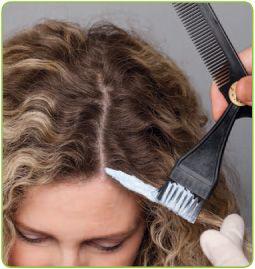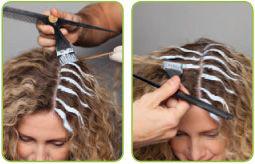B003YL4KS0 EBOK (27 page)
Authors: Lorraine Massey,Michele Bender

Contrary to what many people believe, color and curls
do
mix, especially with today’s available color processes that can keep hair healthy looking. You just have to take into account the special needs of curly hair and use color sensibly. Curly hair absorbs damaging chemicals more easily because the cuticle around the hair shaft is open. “It also takes longer to recover from any damage, because curly hair is so porous,” says Denis DaSilva, co-owner of Devachan.

Denis and the DevaColor team agree that semipermanent and demipermanent colors are the best choices for curly hair, actually for all hair. Semipermanent color is not as damaging to the hair because it doesn’t remove any of the natural color. Demipermanent color is more effective on gray hair, which may resist a milder coloring
process. “The best time to use permanent color, which offers more coverage, is on very hydrated, healthy hair,” says Larry Bianco, a DevaColor expert. “But if hair is dehydrated, any chemical process will deteriorate the hair fiber even more. Not only will the hair be unhealthy, your color won’t look good.” The fewer ammonia-based products you use on your hair, the less dehydrated it becomes.
At Devachan, we usually recommend that clients come back every four to six weeks for color. But that time frame depends on how fast your hair grows, your personal tolerance for exposed roots, and how close your artificial color is to your natural shade. Roots that are close in shade to your colored hair won’t be as noticeable, while those that are drastically different in color will create an obvious line of demarcation like a landing strip (see
page 147
for a hair pinning technique to help hide roots).
When it comes to choosing a color, we advise clients to avoid dramatic color transformations overnight. Start with a demi- or semipermanent color that’s close to your own or two or three tones lighter. Live with that color for a while before doing anything more drastic. Remember that the depth and dimension of color will change as the curls return to their natural state. As I often tell my clients, blond shouldn’t be built in a day. If you want to go from dark brown to blond, build in the color gradually. I began by having a few handpicked curls highlighted. I loved the results and the positive feedback I was getting, so I gradually added more. . . naturally!
Curly girls can also have fun playing with highlights a few shades brighter than their natural color. At Devachan, we specialize in Pintura, a highlighting technique that Denis invented. “Here, the colorist picks out the more raised three-dimensional pieces of hair, which best reflect light, and paints highlights onto dry hair curl by curl,” Denis says. “This brings attention to certain parts of the curl and creates dimension, something curly hair needs, by putting light in an area where there naturally is none.”


The Pintura technique also gives the colorist more control over where he or she places the highlights. By painting them on deliberately and individually, you’re guaranteed perfect placement from roots to the ends and you’ll see the highlights exactly where they’ve been applied.
“This control is important because placement matters when it comes to curly hair,” says Edward Fagley, a DevaColor expert. If highlights are too close together and they overlap on previously colored hair, which happens if the traditional foil method of highlighting is used, then you lose dimension. But with the Pintura method, you can leave just enough space between each curl to create a ribbon of light and dimension. Highlighting using foil can also bake and break curly hair, which is fragile.
If you’re an advanced curly girl, then you have what I call a healthy foundation of hydration. You don’t have to do anything different before getting your hair colored because your hair is already conditioned. But if you haven’t been doing the Curly Girl Method yet, start to condition your hair daily a few weeks before getting color. It’s like priming a wall before painting so you get better results. Also, steer clear of detergent-filled shampoos. If you’re opting for a new style, or getting your hair trimmed or shaped, have your hair cut first and while it’s dry, because the shape of the cut helps determine the color placement. Then do your part, by coming to the salon with your curls as you usually wear them, so the stylist and colorist can see your hair in its most natural state.
“Only two people should know that I color my hair. My haircolorist and me.”
—C
ORNELIA
P
ECKMAN
SKIP THE GLOSSESMany salons offer treatments called glosses and glazes that promise you a head full of shiny hair. “But in my opinion,” Larry says, “gloss is something that goes on a car and glaze goes on a doughnut.” In general, curly hair just isn’t as shiny as straight hair. Straight hair lies flat, so light can bounce off its smooth surface, making it shine. But curly hair’s more porous surface and concave areas don’t reflect as much light. Glosses and glazes can also clog the hair’s cuticle, making it difficult to hydrate the hair properly afterward. The best way to get your hair looking its shiniest is to follow the Curly Girl Method so that hair is well hydrated.

After you get color, treat your hair with special TLC (Tender Loving Conditioning), using one of the moisturizing treatments recommended in
chapter 8
(see
page 77
). All hair, but particularly curly hair, takes a few days to settle after being color-treated. The depth perception and dimension of color will blend and look amazing in no time, especially when you’re a shampoo-free curly girl. Remember that the more often you shampoo your hair, the more quickly the color will fade.
A lot of clients ask how they can keep their gray hair but make it look beautiful. The first thing I tell them is that silver foxy hair
is
beautiful. It can be elegant and it is sexy. The problem seems to be with the word
gray
, which has a social stigma implying old or worn, especially when it comes to women. My first piece of advice is to change the way you think about your strands. Call them “silver” and think of them as natural and beautiful.

CURL CONFESSIONSandra Gering
art dealerAt the age of sixty-one, when I was diagnosed with breast cancer, I shaved off all my hair rather than enduring the pain of watching it fall out from chemotherapy. As soon as I was done with chemo, the hair I’d lost started to grow back. Except now, instead of wavy platinum-blond hair, it was baby curls that were silver.
I didn’t know how to handle my new hair, so I looked to my curly haired friends for direction. After using the right products, my hair came back strong, shiny, and thick, and it looked so good that I decided to leave it natural. I constantly get compliments on how pretty the silver color is. When one old friend suggested I go back to being a blonde, I told him I was no longer that person. I am who I am now and I like the naturalness.
Soon after my hair grew back, I went to Italy on vacation. There I met a much younger man—he was thirty-seven years old—who became my lover. I think my curls helped attract him. It was wonderful, and our romance lasted for two years.


